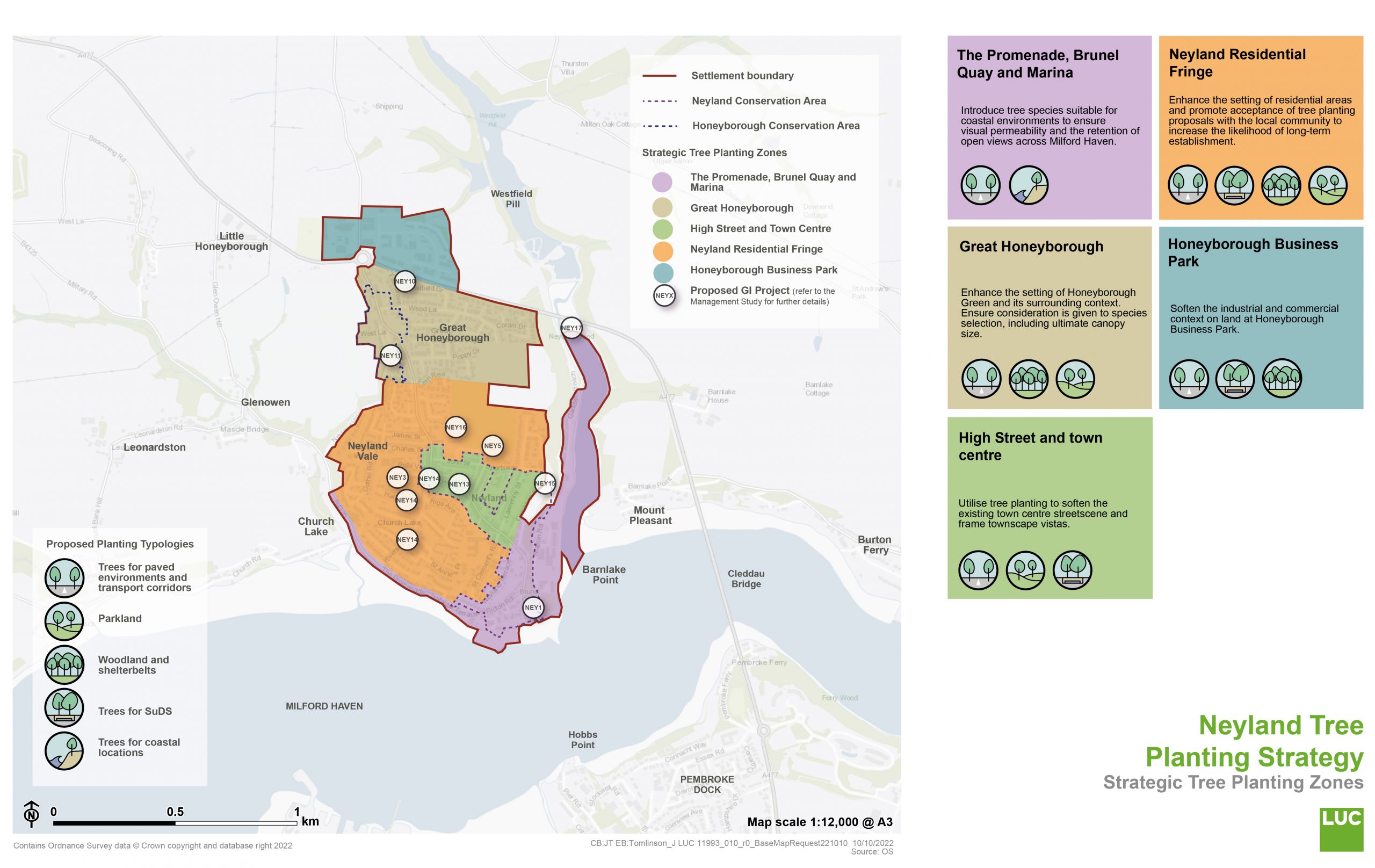- Consider integrating trees to soften the expansive car park areas and enhance the setting of key arrival points, whilst ensuring the location of new trees does not interfere with existing uses. Integrate trees in small clusters to create a microclimate to improve growing conditions and allow incorporation of shared growing pits / rooting space in hard landscape.
- Ensure landscape management and future tree planting maintains key views, such as from the promenade and seating areas along Station Road. This should be achieved utilising well-spaced trees with clear stems / high canopies. Widely spaced, small groups of trees may also be appropriate at the edges of small areas of green space set back from the seafront.
- Utilise tree planting to soften and screen industrial areas and green routes along Station Road and Gaddam Reach.
Neyland Tree Planting Zones and Sub-Principles
Tree Planting Zones and Sub-Principles for Neyland are shown on the map and drop down list below. Click on the headings to expand.
Neyland Strategic Tree Planting Zones - Download image

×![]()
Neyland Strategic Tree Planting Zones
Zones and Sub-Principles
Land encompassed within Neyland Conservation Area and Honeyborough Conservation Area includes the spaces between buildings and existing trees within the designated areas. Pembrokeshire County Council (PCC) should therefore be contacted prior to the commencement of works on existing trees subject to a Tree Preservation Order (TPO) or those located within the boundary of either conservation area.
- Implement infill planting and new planting of flowering trees along Honeyborough Road, enhancing a key route towards the centre of Neyland.
- Maintain or increase tree canopy cover at Honeyborough Green. Ensure planting density and tree form / size, maintains the village green character.
- Protect and enhance belts for trees to act as a buffer and screen for the A477 and adjacent industrial area.
- Ensure tree planting complements and does not detract from the distinctive townscape character.
- Ensure views from key routes (such as the High Street) are not obscured by inappropriate tree planting. Trees may be best placed at key entrances, fringes and wider junctions, utilising narrow form trees to maintain sightlines where needed. Maintain long range views from the edge of the area from elevated viewpoints (such as at Cambrian Road).
- Use small specimen trees to soften hard landscape areas and create a sense of arrival at key visitor hubs (such as High Street Car Park).
- Protect, and if appropriate increase, canopy cover at incidental areas of green space leading off the High Street to maintain and enhance townscape character (e.g. at Windsor Gardens, Lawrenny Street, Railway Terrace).
- Utilise tree planting to enhance the setting of residential areas, creating tree lined streets where possible. Sufficient consideration should be given to species selection, ultimate canopy size and maintenance requirements to promote long-term establishment and reduce interference with buildings and services (e.g. telegraph lines / lighting columns).
- Avoid proposals which conflict with private vehicular access points on residential streets.
- Tree planting proposals should avoid obstruction of highways and Public Rights of Way (PRoW) within the residential context.
- Prioritise tree planting in areas with the least site constraints, such as larger areas of amenity grassland and wide verges. This includes areas with minimal recreational value due to small size.
- Where possible, link up and extend existing, fragmented rows of street trees within grass verges (e.g. along Riverside Avenue).
- Enhance the character of local open spaces, sport and community facilities with boundary trees, seeking opportunities to plant larger canopy parkland trees as a priority (such as Neyland Community Hub). Ensure sightlines are maintained to provide a sense of safety and security.
- Increase tree cover to soften the views towards industrial development. This may include wider verges at key entrances (such as the A477 roundabout).
- Ensure greening of streets through tree planting, especially where any upgrades of access roads or car parks is undertaken. Utilise tree planting to screen buildings to nearby residential areas and the wider landscape. Ensure new tree planting is required as part of future industrial development.
